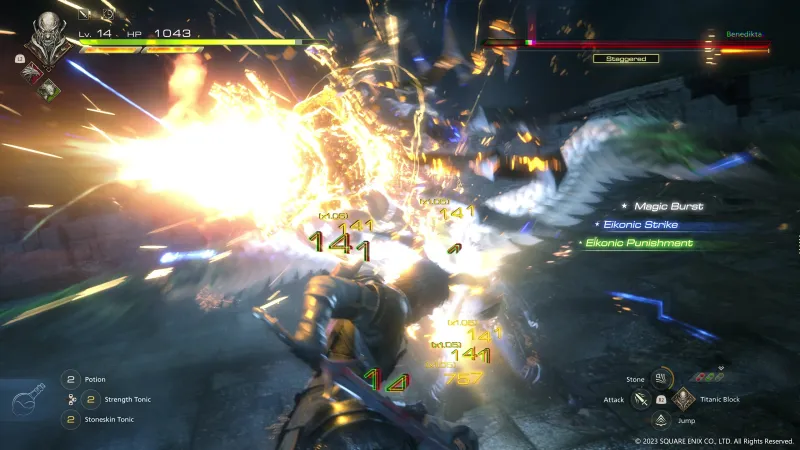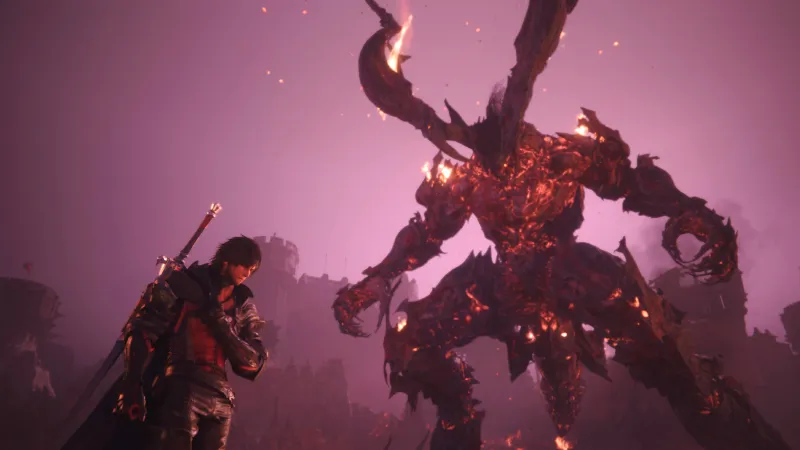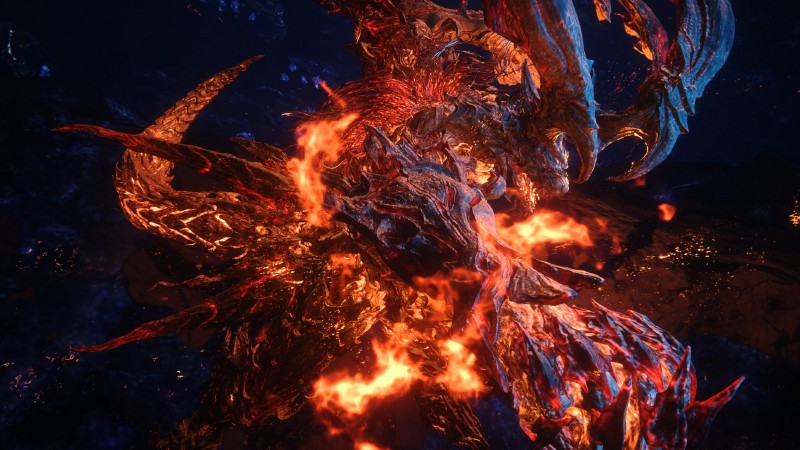Final Fantasy XVI is bombastic, indulgent, and extreme, far exceeding the limits of what I thought an action-oriented Final Fantasy could succeed at. It represented a significant change for the series, abandoning turn-based move selection, active-time battles, or anything in its history in favor of a fast-paced, extravagant, combo-heavy battle system. Which is increasing continuously. Stayed strong throughout my 60+ hour journey.
FFXVI has a linear action game, and it’s one of the highlights of the experience. But the game’s more open nature outside of standard RPG tropes, mechanics, and story-based dungeon explorations slows down an otherwise explosive story about gods, icons, crystals, and the meaning of free will. Still, Final Fantasy XVI’s heights are easily among the highest in the series and even among action games.
FFXVI’s tagline reads, “Crystal’s legacy has long shaped our history.” This is a topic that you will find yourself discussing throughout the game. Narratively, the protagonist Clive Rosefield and his band of outlaws, consisting of Sid, Jill and several other outstanding actors, are revolutionaries. In more ways than one, they set out to topple the pillars of Valstian society that have only grown stronger throughout history, in an attempt to reshape life on the continent.
The story begins as a tale of revenge against the backdrop of slavery; In Valystia, Bearers, or people who can use magic, are enslaved, traded, and sold to whoever and wherever needs them. FFXVI fails to say anything new or noteworthy on this front; One omission made even more glaring is that there are only a few people of color in FFXVI’s main cast. Inspired by medieval Europe, FFXVI features majority-white artists commenting on and fighting against slavery and the systems that perpetuate it, often with little knowledge or representation of the types of real-world people affected by slavery. The biggest mistake is.
The story eventually abandons that discussion to focus on other, more common pillars of Valystian life that must be toppled. And this is where the story shines. Although sometimes it’s a little too close game of Thrones Inspired to feel original, the voices cast behind these characters nevertheless commit to every beat, and it works. Final Fantasy fans and enthusiasts of series like Kingdom Hearts who like a dose of raunchy love in their stories (both romantic and platonic) will enjoy FFXVI’s performance.
FFXVI’s story is bolstered by a visual style that is, at times, gorgeous, though there are areas where I’m less impressed, even disappointed. NPC models, especially models for non-main characters, are often plastic and in stark contrast to the main cast. Performance mode struggles to reach 60fps, but even when it does, it fails to stay consistent.
FFXVI is more stylized than realistic, very much a “medieval Final Fantasy”. The overall visual presentation shines when the visual pieces, such as the UI, environments, and flashy battle effects, mix. However, sometimes it’s hard to understand what’s going on.

Areas with open ground are the least affected. They’re large but mostly unmemorable empty spaces, barring the occasional side quest, random treasure or horde of enemies. Their emptiness reflects my biggest issue with FFXVI – it’s an excellent action game, but the same can’t be said about it as an RPG. There are dozens of crafting materials, and I can’t tell you about one because crafting in FFXVI is less a system and more a word. There are no weapons with which to do better This type of construction or He – only the strongest have a weapon, and it is clear that this is the one you should make. And save some endgame weapons, you’ll always have the necessary materials if you complete story missions and the occasional side quest. The same applies for other pieces of gear.
These iconic powers are where FFXVI’s RPG mechanics come in handy. As Clive gains the powers of more Eikons throughout the story, he gains access to new abilities, allowing you to iterate on your build. I especially fell in love with my Phoenix-Garuda-Bahamut combo. Additional accessories reinforced this, such as reducing the cooldown of my heavy-handed Phoenix attack by 12 seconds. But other than these abilities and helpful equipment, FFXVI is disappointingly linear for an RPG. Players who access the credits will likely have access to most of the same weapons, accessories, and skills. This is how they mix and match where the diversity of playing styles is visible.
Side quests are almost always some variation of the fetch quest. Talk to this person, go here, attack some enemies, and return for your reward. And while that’s not always the case, many of them contain a surprising amount of dialogue and description, and it’s usually worth a read. Creative Business Unit III adds a quality-of-life feature I’d like to see in every RPG — a side quest with a plus sign on the marker means that completing it will reward you with something beyond gil or resources. From this marker I knew to complete side quests that eventually rewarded me with increased potion inventory, potion potency, and even a rideable chocobo.
Plus, many of these sides build on each other, and I love how they bring the world around them to life as the stories progress. This was an especially welcome feeling since Clive is engaged in combat, and FFXVI’s story spans decades. Seeing how the world outside of Clive’s mission changes visually and narratively over time adds extra seriousness to the work I do.
However, the pace and content of these side quests, and indeed anything that happened outside of the main story quests, doesn’t compare to what the main missions are doing, and they feel significantly slower and less exciting as a result. I enjoy gathering new songs to play in my hideaway’s orchestration jukebox and hanging out with loresman Harpocrates to learn new things about Valystia, but these extracurricular activities often feel like a distraction from what I’m really doing. Doing my due diligence more than I wanted to do.
Maybe this is it. Clive and the gang need downtime after what they accomplish in story missions — mind you, missions that left me in constant awe, gave me goosebumps — but well-deserved downtime for the characters doesn’t mean that This is welcome downtime for me. It’s less that everything that happens outside of the main story is rote, but what Creative Business Unit III does in those story missions is so great that I constantly find myself rushing to the next story as quickly as possible.

I’m not exaggerating when I say that there was one moment in FFXVI, a boss fight that lasted over an hour, that I would call my favorite moment in Final Fantasy, and more than that, of gaming. It’s unforgettable and reflects Creative Business Unit III’s confidence in and command of the brand. This moment is almost topped by another later in the game, which marks the extreme highs of FFXVI’s otherwise good and predictably bloated lows of a Final Fantasy RPG.
These peaks are spread so high for a few reasons. Creative Business Unit III has created my favorite action combat system to date. On its surface it is quick and easy to understand. But there’s a lot of depth to it, and how far you want to go with it will depend on how much you’re willing to engage with its various systems. Adding iconic abilities only amps up the action, and I found ability combinations that I came to rely on to stagger and ultimately defeat even the toughest foes. Controlling the Ifrit Eikon during setpiece moments wasn’t as varied as I would have liked from a gameplay perspective, but the spectacle surrounding these moments makes up for it and then some.
Those familiar with FFXIV will find it surprising, but composer Masayoshi Soken’s FFXVI score trumps nearly every element of the game. And I’m not saying that to play a game like that and lower expectations about what’s in it; I say this to raise your expectations about Soken’s score, which features a new personal favorite in the expansive Final Fantasy catalog. Swinging between soft piano keys and strong chorus-backed epics that cover entire scenes, Soken skillfully demonstrated why he’s a fan-favorite Final Fantasy composer multiple times during FFXVI’s runtime.
After more than 65 hours of FFXVI, I still have more to do with the story, and I’m glad my time with Creative Business Unit III’s latest film isn’t over yet. FFXVI has some of my favorite moments in modern Final Fantasy, but its low levels jeopardize the pace at which they arrive. I wish the different elements of FFXVI were more seamlessly intertwined. Yet, when I look back on the time spent with Clive, his friends, his enemies, and Valysthia, these heights are what I clearly miss. FFXVI is very different from its predecessors, but very familiar in many ways; And it’s still a Final Fantasy, which reminds me why I love this series so much.
